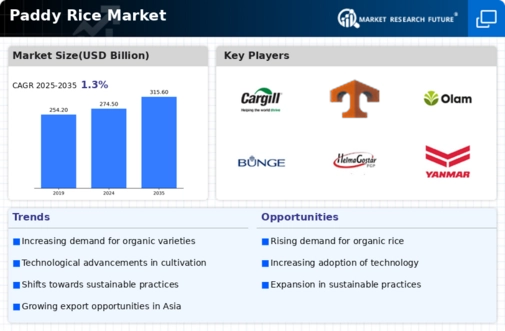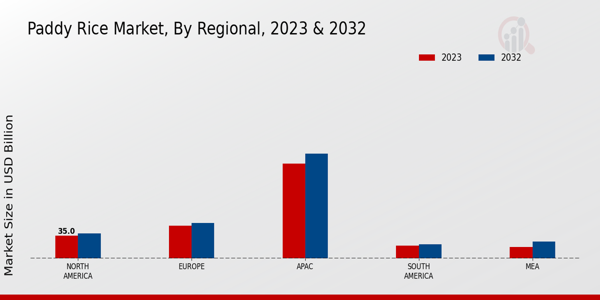Rising Global Population
The increasing global population is a primary driver of the Global Paddy Rice Market Industry. As the world population is projected to reach approximately 9.7 billion by 2050, the demand for staple foods, particularly rice, is expected to surge. In 2024, the market value is estimated at 274.5 USD Billion, reflecting the urgent need for food security. This trend suggests that rice will remain a crucial dietary component, especially in Asia where rice consumption is highest. The Global Paddy Rice Market Industry must adapt to this growing demand by enhancing production efficiency and sustainability practices.
Market Growth Projections
The Global Paddy Rice Market Industry is projected to experience steady growth over the coming years. With an estimated market value of 274.5 USD Billion in 2024, it is anticipated to reach 315.6 USD Billion by 2035. This growth trajectory indicates a compound annual growth rate (CAGR) of 1.27% from 2025 to 2035. Such projections reflect the ongoing demand for rice as a staple food, particularly in Asia, where consumption remains high. The market's expansion is likely to be driven by factors such as population growth, technological advancements, and evolving consumer preferences.
Growing Health Consciousness
The rising awareness of health and nutrition among consumers is impacting the Global Paddy Rice Market Industry. As more individuals seek healthier dietary options, there is a noticeable shift towards organic and whole grain rice varieties. This trend is particularly evident in developed markets where consumers are willing to pay a premium for products perceived as healthier. Consequently, rice producers are increasingly focusing on organic farming practices to cater to this demand. This shift not only enhances the market's diversity but also aligns with the broader global movement towards sustainable and health-oriented food choices.
Government Policies and Subsidies
Government interventions play a crucial role in shaping the Global Paddy Rice Market Industry. Various countries implement policies and subsidies aimed at boosting rice production and ensuring food security. For example, nations like India and Vietnam have established minimum support prices for rice, encouraging farmers to increase their output. Such measures not only stabilize prices but also enhance farmers' income, thereby promoting investment in agricultural technology. These supportive policies are likely to sustain the market's growth trajectory, with a projected CAGR of 1.27% from 2025 to 2035.
Climate Change and Environmental Concerns
Climate change poses significant challenges to the Global Paddy Rice Market Industry, affecting production patterns and crop yields. Fluctuating weather conditions, such as increased flooding and droughts, can disrupt rice cultivation, particularly in vulnerable regions. As a response, the industry is exploring adaptive strategies, including the development of climate-resilient rice varieties and sustainable farming practices. These initiatives are crucial for maintaining production levels amidst environmental uncertainties. The industry's ability to adapt to these challenges will be pivotal in sustaining growth and meeting the projected market value of 315.6 USD Billion by 2035.
Technological Advancements in Agriculture
Technological innovations in agricultural practices are significantly influencing the Global Paddy Rice Market Industry. The adoption of precision farming, genetically modified organisms, and advanced irrigation techniques has the potential to enhance yield and reduce resource consumption. For instance, the use of drones for monitoring crop health and automated machinery for planting and harvesting can lead to increased productivity. As the market evolves, these technologies may contribute to a more resilient supply chain, ensuring that the industry meets the anticipated growth from 274.5 USD Billion in 2024 to 315.6 USD Billion by 2035.









